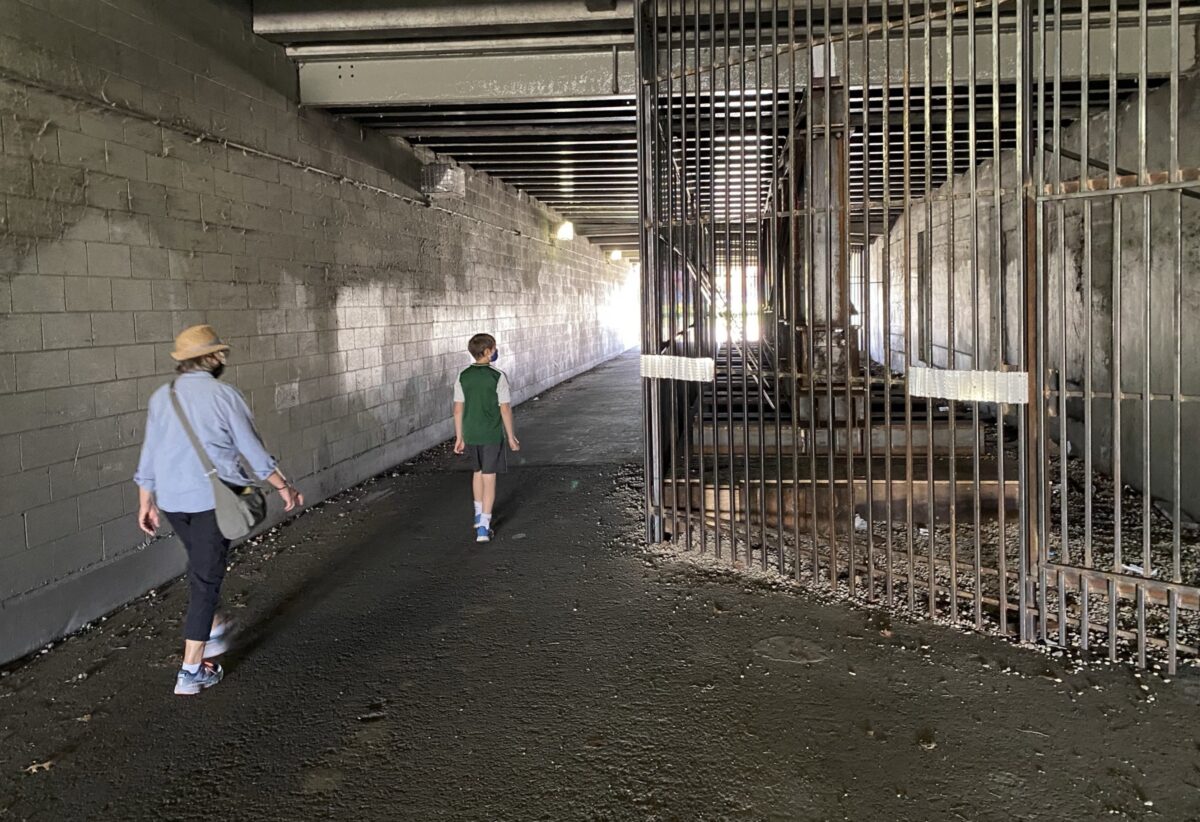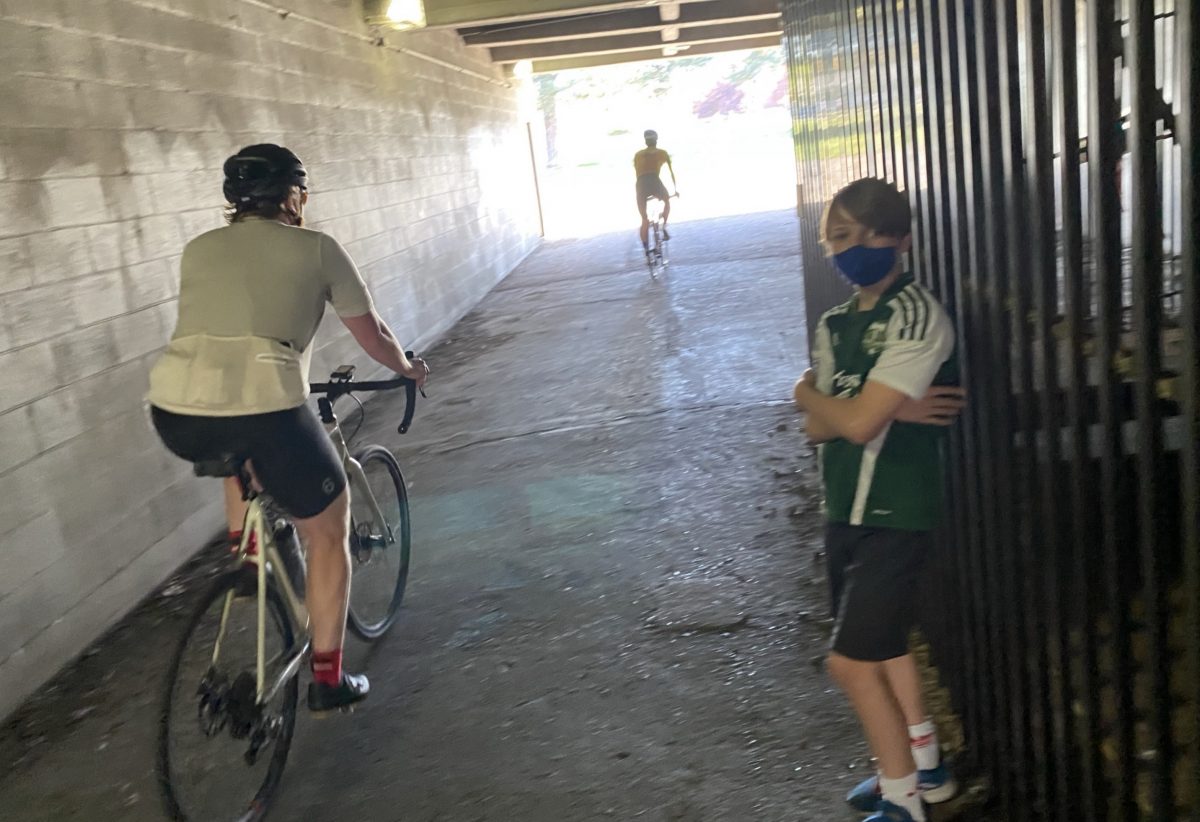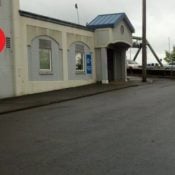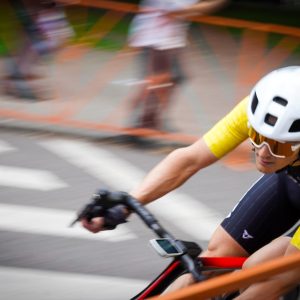
(Photos: Jonathan Maus/BikePortland)
The path that gets bicycle riders and walkers across the Columbia River adjacent to I-5 between Portland and Vancouver is notoriously terrible. Riders are routed onto dangerous crosswalks, sidewalks, and are forced to use “beg buttons” just to get onto the narrow path that goes across the river.
With my parents in town for a visit this week, I recently met them at their hotel on Hayden Island for a walk across the river to Vancouver (their new riverfront developments are wonderful!).
On our way back, as we walked down the path on the southbound side of the bridge, I was very surprised to see a huge obstruction in the middle of the tunnel that goes under the freeway.
This tunnel is not well-lit and is poorly maintained in general. It was never a favorite part of the crossing to me. Now there’s a huge steel cage structure that protrudes well over half the width of the path. I didn’t notice any temporary or permanent warning signage of any kind. The only safety measures that have been taken by ODOT thus far are two small white reflective strips placed about eye level on the structure itself.
I also don’t recall ever being notified by ODOT about this project and how it would impact path users.
Advertisement
I asked ODOT Region 1 Public Information Officer Don Hamilton for more information.
He said ODOT had to install steel beams to support the tunnel structure so the agency would not be forced to place a weight restriction on trucks using I-5. “We placed the cage around them so the homeless community would not be able to access the area and cause a safety issue with the system.”

The beams and cage were installed sometime between December and April. Hamilton said they have no plans to remove it and it’s likely it will remain in place until a new bridge is constructed.
While my family and I were walking near the cage a few days ago, two bicycle riders rolled by and we had to step back against the railings to get out of their way.
If you ride this tunnel, please slow down and be aware of this obstruction — especially in the southbound direction as downhill speeds might make it harder to turn away from the steel bars at the last second.
One reader already told us they almost hit it. “I had a close call with it for the first time just this week. Let’s just say If you’re coming off the southbound ramp with some speed and there’s other people milling around and an on-coming rider it would come as a bit of a surprise.”
— Jonathan Maus: (503) 706-8804, @jonathan_maus on Twitter and jonathan@bikeportland.org
— Get our headlines delivered to your inbox.
— Support this independent community media outlet with a one-time contribution or monthly subscription.









Thanks for reading.
BikePortland has served this community with independent community journalism since 2005. We rely on subscriptions from readers like you to survive. Your financial support is vital in keeping this valuable resource alive and well.
Please subscribe today to strengthen and expand our work.
This should be a strong warning to anyone who believes that the CRC2.0 project is going to improve the crossing for people outside cars. ODOT is only concerned about not inconveniencing motorists and I suspect the bike facilities may well be worse on any new bridge built as part of the proposed freeway widening project.
In my view, cage isn’t much of a problem, except that in the time of covid, I’ve found myself not as socially distanced as I want to be with individuals who are hanging out under the bridge because of it, which is a health concern.
Since it is nearby, I wanted to get people’s take on this: On the I-5 Southbound bridge walking/biking lane, there is a sign that was recently added at the high point of the bridge crossing that reads something like “yield to oncoming bikes”. I understand that typically downhill riders yield to uphill riders, but in this situation this is wholly inappropriate because there is a lane for Northbound bikes and a lane for Southbound, so the Northbound shouldn’t be coming up the Southbound lane anyway. This is frequently an issue when I regularly cross the bridge, and a frustrating one, in my view.
Regarding outside Covid transmission there are a lot of articles talking about this lately, here is only one.
https://slate.com/technology/2021/04/masks-outside-covid-risk-low.html
I wouldn’t worry about zipping through that underpass. Does it even take 15 seconds to get through there??
Yep, valid point
You’re not wrong, but it didn’t seem to be the popular point of view when I suggested it applies to the Broadway Bridge. People seem to have feelings about enforcing the convention when it’s not explicit, no matter how uncomfortable it can be to pass in the same direction on either bridge, much less oncoming at very different speeds.
When I visited Birmingham Alabama this last fall, they had a tunnel very similar to this one (but under railroad yards). To light up the tunnel (and to deter the homeless) they put in a flashing neon arts installation and played post-modern classical music 24/7. Quite effective too.
That is a cool idea. In Portland however the speakers would be bashed in and the art installation torn down.
I don’t doubt that the support was needed, but that doesn’t mean it had to be built the way it was. Even with the beam and columns in the same place, the horizontal members that spread the load out at the base could have been recessed into the ground slab, so you’d end up with the same wide tunnel with columns, but no cage and no other width reduction (as one example of an alternative design). The design that was done looks like a makeshift retrofit done with no regard to impact on tunnel users.
This is something I really hate about how agencies like this respond to anything involving construction or codes–“Sorry, we had no choice–engineering and codes”. They rely on the public not having technical knowledge, and since most people don’t, they get away with it.
I can see this being a legitimate solution if the new bridge were funded and a year or two from groundbreaking. But it’s not. It could be interesting to ask ODOT if it ever even bothered exploring other solutions (and provide cost estimates or other evidence if they say they did).
A new bridge with a truly wonderful facility for bicyclists and pedestrians would be under construction right now if the republicans in the Washington state senate hadn’t refused to continue funding for the CRC project seven years ago.
If one refuses to build new projects to replace ancient ones that exceeded their useful life decades ago, one should not be surprised when agencies have to make ad hoc repairs and modifications to the old ones. It looks to me like the cage keeps people away from emergency structural supports.
CRC 2.0 may well cost as much as the original CRC 1.0 and it might have facilities for bicyclists and pedestrians that are not as good.
> … refuses to… replace ancient ones that exceeded their useful life decades ago…
The bridges are still useful, hence all the people that.. you know… use them.
I don’t know if you are just playing word games or you really don’t understand useful life. For an analogy in the bicycle world, the useful life of your drive chain is about 1500 miles. Yes, it will work for 3000 miles or more, but the wear on other components (chainring and cogs) will make those components wear prematurely and cost you more in the end.
Yep! Though I would expect the construction costs – if the exact same project were built today – would be 200% what the CRC1 would have been…the post great recession construction costs were imploding compared to 2005-2008, plus materials and labor will be up and city center commercial land values now are easily 3x.
HALF of the budget for CRC 1.0 was rebuilding/expanding freeway interchanges. It was an incredible waste of money and was rightfully cancelled. WSDOT/ODOT need to learn about value engineering. Re-use as much existing infrastructure as possible.
Oh, and since you are so passionate about replacing aging infrastructure, don’t you think we should be focusing on the railroad bridge just downstream of the CRC? It is older than both CRC bridges and is the only railroad bridge over the Columbia in our region.
You have to rebuild the interchanges if the bridge is constructed at a substantially higher elevation than the current bridge (as was proposed so the lift span could be eliminated). If you care to review the history, retaining the existing bridges was examined and found to be lacking for many reasons – seismic vulnerability, 24/7/365 staffing for bridge lifts, continued maintenance costs, Coast Guard concerns about maintaining navigation channels, and more.
Value engineering might well have have resulted in elimination of all but the minimum facilities for bicyclists and pedestrians since their use was so small in relation to that of motorists.
The railroad bridge is a private facility owned by a publicly traded company. It’s up to the shareholders, not the taxpayers, to fund the improvements.
Cool, on you checking on the Couve with the fam.
If this is any example of ODOT’s engineering and architectural prowess, I can’t wait to see what they come up with for CRC 2.0.
Yes, maintenance activités and works zones are typically “under communicated” and kept tight within small sections of all DoT/ public works…the implementation and outcome of this solution is not too surprising…I guess we could be “thankful” they did not close off the access 100% given how they have acted in the past on the Interstate Bridge regarding bike ped and ADA access.
Though this “repair” does concern me since I do not think they have done the same on the Vancouver side (as recently as January)…I think I saw that ODoT did a similar reinforcement on the bridgehead approach just north of this section.
It looks like this is fairly substantial bracing under the existing structure, which would indicate a fairly major problem. We should be happy that they didn’t have to close this underpass completely.
This is true, though the “major problem” was reducing freight weight limits. Without a public review process, we’ll never know what other options were available. Some of which might have also included non-motor vehicle access improvements.
This is a bit of an escalation from the typical “steel plate in roadway” sign completely blocking a bike lane.